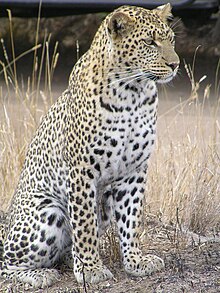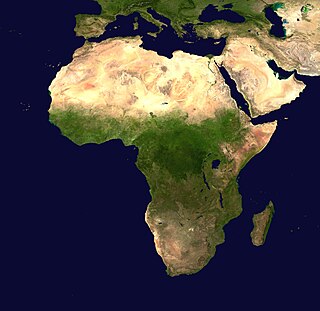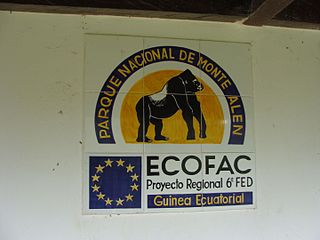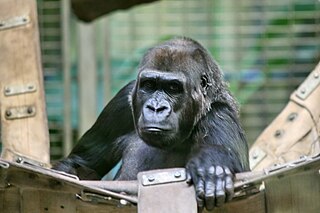
The wildlife of Equatorial Guinea is composed of its flora and fauna.

The wildlife of Equatorial Guinea is composed of its flora and fauna.
There are approximately 3,250 species of plants. [1] Africa has high animal diversity. There are at least 194 mammal species; 418 species of birds, and 91 reptile species. [1]
Mammals are found throughout Equatorial Guinea. Within Equatorial Guinea there are gorillas, leopards, chimpanzees, a small population of African elephants, hippopotamus, Cape buffalo, crocodiles, pythons and various monkeys.
The gorillas of Equatorial Guinea are the western lowland gorilla subspecies. The elephants are African forest elephants. Despite poaching, the leopard is widespread and is found even in the suburbs of some major cities. For a full list of mammals, see List of mammals of Equatorial Guinea.

The natural history of Africa encompasses some of the well known megafauna of that continent.

The Niokolo-Koba National Park is a World Heritage Site and natural protected area in south eastern Senegal near the Guinea border. It is served by Niokolo-Koba Airport, an unpaved airstrip.

The Congolian rainforests are a broad belt of lowland tropical moist broadleaf forests which extend across the basin of the Congo River and its tributaries in Central Africa. They are the only major rainforests which absorb more carbon than they emit.

The wildlife of Cameroon is composed of its flora and fauna. Bordering Nigeria, it is considered one of the wettest parts of Africa and records Africa's second highest concentration of biodiversity. To preserve its wildlife, Cameroon has more than 20 protected reserves comprising national parks, zoos, forest reserves and sanctuaries. The protected areas were first created in the northern region under the colonial administration in 1932; the first two reserves established were Mozogo Gokoro Reserve and the Bénoué Reserve, which was followed by the Waza Reserve on 24 March 1934. The coverage of reserves was initially about 4 percent of the country's area, rising to 12 percent; the administration proposes to cover 30 percent of the land area.

The wildlife of Chad is composed of its flora and fauna. Bush elephants, West African lions, buffalo, hippopotamuses, Kordofan giraffes, antelopes, African leopards, cheetahs, hyenas, and many species of snakes are found there, although most large carnivore populations have been drastically reduced since the early 20th century. Elephant poaching, particularly in the south of the country in areas such as Zakouma National Park, is a severe problem.

The wildlife of the Democratic Republic of the Congo includes its flora and fauna, comprising a large biodiversity in rainforests, seasonally flooded forests and grasslands.
The wildlife of Gabon is composed of its flora and fauna. Gabon is a largely low-lying country with a warm, humid climate. Much of the country is still covered by tropical rainforest and there are also grasslands, savannas, large rivers and coastal lagoons.

The wildlife of Liberia consists of the flora and fauna of the Republic of Liberia. This West African nation has a long Atlantic coastline and a range of habitat types, with a corresponding diversity of plants and animals. Liberia is considered a biodiversity hotspot and has more intact forests characteristic of the Upper Guinea Massif than do neighbouring countries. There are 2000 species of vascular plants, approximately 140 species of mammals, and over 600 species of birds.

The state of Karnataka in South India has a rich diversity of flora and fauna. It has a recorded forest area of 38720 km2 which constitutes 22.3467719% of the total geographical area of the state. These forests support 25% of the elephant population and 20% of the tiger population of India. Many regions of Karnataka are still unexplored and new species of flora and fauna are still found. The Western Ghats mountains in the western region of Karnataka are a biodiversity hotspot. Two sub-clusters of the Western Ghats, Talacauvery and Kudremukh in Karnataka, are in a tentative list of sites that could be designated as World Heritage Sites by UNESCO. The Bandipur and Nagarahole national parks which fall outside these subclusters were included in the Nilgiri biosphere reserve in 1986, a UNESCO designation. Biligiriranga Hills in Karnataka is a place where Eastern Ghats meets Western Ghats. The state bird and state animal of Karnataka are Indian roller and the Indian elephant respectively. The state tree and state flower are sandalwood and lotus respectively. Karnataka is home to 524 tigers.

The wildlife of Uganda is composed of its flora and fauna. Uganda has a wide variety of different habitats, including mountains, hills, tropical rainforest, woodland, freshwater lakes, swamps and savanna with scattered clumps of trees. The country has a biodiverse flora and fauna reflecting this range of habitats and is known for its primates, including gorillas and chimpanzees. There are ten national parks and thirteen wildlife reserves; some 345 species of mammal and 1020 species of bird have been recorded in the country.

The wildlife of Nigeria consists of the flora and fauna of this country in West Africa. Nigeria has a wide variety of different habitats, ranging from mangrove swamps and tropical rainforest to savanna with scattered clumps of trees. About 290 species of mammal and 940 species of bird have been recorded in the country.
Odzala-Kokoua National Park is a national park in the Republic of the Congo. The park was first protected in 1935, declared a biosphere reserve in 1977, and granted official designation by presidential decree in 2001. Odzala-Kokoua has approximately 100 mammals species, and one of the continent's most diverse primate populations. The nonprofit conservation organization African Parks began managing the park in collaboration with the Ministry of Forest Economy, Sustainable Development and Environment of the Republic of the Congo in 2010.

The Atlantic Equatorial coastal forests, also known as the Congolian coastal forests, are a tropical moist broadleaf forest ecoregion of Central Africa, covering hills, plains, and mountains of the Atlantic coast of Cameroon, Equatorial Guinea, Gabon, Republic of the Congo, Angola, and Democratic Republic of the Congo.

Monte Alén National Park is located near the center of Equatorial Guinea. It was established in 1990. With an area of 2,000 square kilometres (770 sq mi), it is the country's largest national park. The goliath frog (Conraua goliath), one of the prominent amphibians found in the park, is the biggest frog in the world; hunting it is prohibited.

Wildlife in the Central African Republic is in the vast natural habitat located between the Congo Basin's rain forests and large savannas, where the human density was smaller than 0.5 per km2 prior to 1850. The forest area of 22.755 million, considered one of the richest storehouses of wildlife spread over national parks, hunting reserves and community hunting areas, experienced an alarming loss of wildlife because of greed for ivory and bushmeat exploitation by hunters – mostly Arab slavers from across the borders of the Central African Republic with Chad and Sudan.

The Kahuzi-Biega National Park is a protected area near Bukavu town in eastern Democratic Republic of the Congo. It is situated near the western bank of Lake Kivu and the Rwandan border. Established in 1970 by the Belgian photographer and conservationist Adrien Deschryver, the park is named after two dormant volcanoes, Mount Kahuzi and Mount Biega, which are within its limits. With an area of 6,000 square kilometres (2,300 sq mi), Kahuzi-Biega is one of the biggest national parks in the country. Set in both mountainous and lowland terrain, it is one of the last refuges of the rare species of Eastern lowland gorilla, an endangered category under the IUCN Red List. The park is a UNESCO World Heritage Site, inscribed in 1980 for its unique biodiversity of rainforest habitat and its eastern lowland gorillas. In 1997, it was listed on the List of World Heritage in Danger because of the political instability of the region, an influx of refugees, and increasing wildlife exploitation.